Use 'Print preview' to check the number of pages and printer settings.
Print functionality varies between browsers.
Printable page generated Friday, 26 April 2024, 4:20 PM
Study Session 2 Background to the OWNP
Introduction
The development of the water, sanitation and hygiene, or ‘WASH’ sector in Ethiopia is said not to have a long history (not more than two decades). Nevertheless, it is important for you to know how the sector has reached its current status and how it has been influenced by past policies and strategies.
This study session outlines the key policies and strategies that existed in the WASH sector prior to the One WASH National Programme (OWNP). It describes their history and how they are enacted, and explains how the different policy documents relate to each other. This will help you understand how, at an operational level, plans and projects have been implemented.
Note that the sections of this study session that describe the various policies, strategies and programmes are only brief summaries of these important documents. If you would like the full details, you can find the original documents by following the information in the References list.
Learning Outcomes for Study Session 2
When you have studied this session, you should be able to:
2.1 Define and use correctly all of the key words printed in bold. (SAQ 2.1)
2.2 Summarise the background of the WASH sector in Ethiopia. (SAQ 2.2)
2.3 Describe the key policies related to the WASH sector. (SAQ 2.3)
2.4 Understand the differences between the main water policy, strategy and programme. (SAQ 2.4)
2.5 Outline the major national development plans relevant to WASH. (SAQ 2.5)
2.1 Background of WASH in Ethiopia
Ethiopia faces many challenges to provide safe water for all, however the country is not short of water. Across Ethiopia as a whole there is relatively high rainfall and there are many large rivers. It has been estimated that the annual surface run-off in Ethiopia is 122.8 billion m3 and groundwater potential is 2.6 billion m3 (Tafesse, 2008). However, these water resources are not distributed evenly, either by geographical area or through the year. Figure 2.1 shows a map of the main river basins of Ethiopia. 80–90% of Ethiopia's water resources is found in four river basins in the west of Ethiopia namely, Abbay (Blue Nile), Tekeze, Baro Akobo and Omo. These areas have most of the water but only about one third of the Ethiopian population lives in these regions. The east and central river basins have only 10–20% of water resources but the population there is over 60% of the total (MoWR, 1999).
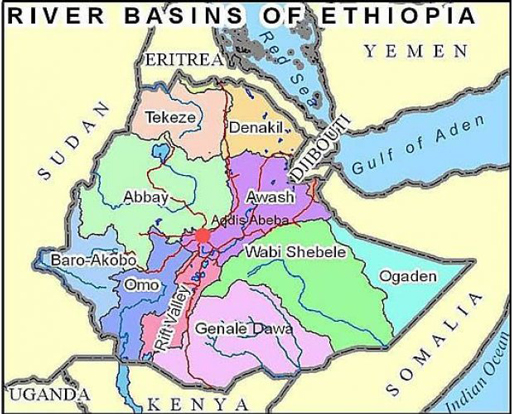
The unevenness of distribution over time is also a problem. As you will know, different parts of the country have marked wet and dry seasons which means water is not always available when needed. Furthermore, the predicted seasons are not always reliable and rains may come early or late, or not at all in some years.
This mismatch in distribution means that water is not available at all times for everyone. This, coupled with limited financial and technical resources, has meant that Ethiopia’s abundant water resources have not been utilised to their full potential. Furthermore, there are the challenges facing the WASH sector that you learned about in Study Session 1. However, despite these many difficulties, there have been significant improvements in water supply and sanitation provision over the past 25 years. Figure 2.2 shows how access to water and sanitation has improved since 1990.
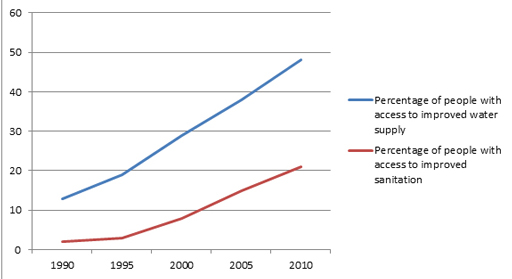
The population of Ethiopia in 2010 was approximately 87 million. Using data from Figure 2.2, how many people, to the nearest million, did not have access to improved water supply and how many did not have improved sanitation at that time?
Reading from the graph, 48% of people had access to improved water in 2010. 48% of 87 million is 42 million (87 × 0.48). The figure for sanitation is 21%. 21% of 87 million is 87 × 0.21 = 18 million. The question asks for numbers of those who did not have access, therefore the answers are 87 − 42 = 45 million people did not have access to safe water and 69 million did not have access to improved sanitation.
Note that the data in Figure 2.2 is for the total population of Ethiopia, but you should also be aware of the differences between urban and rural areas. WASH provision in urban areas is generally much better. By 2012, 97% of people living in urban settings as opposed to 42% of the rural population had access to improved water. For open defecation, only 8% of urban dwellers compared to 43% of rural populations were practising open defecation in 2012 (JMP, 2014a). As a proportion of the total, far fewer people live in towns than in rural areas (less than 20%), but the density of the population is much greater in urban areas than in the countryside. In many cities the rivers and streams have become open sewers polluted with human wastes of all types (Figure 2.3).
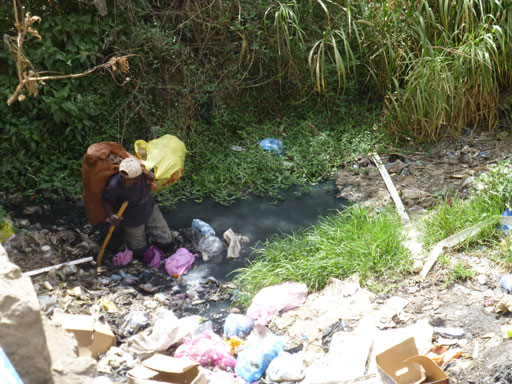
The improvements over recent decades indicated in Figure 2.2 have come about in part because of developments in national plans and policies to address the problems of WASH. The following sections describe the main policies, strategies and programmes that preceded and established the foundation for the OWNP.
2.2 Policies in the WASH sector
This section is about the policies designed by the Ethiopian government that have shaped the WASH sector and led to the OWNP. By policy we mean a high-level statement of overall purpose and principles that will guide plans and decisions.
The Constitution of the Federal Democratic Republic of Ethiopia (1995), Article 10, sub-articles 1 and 2, state that:
Human rights and freedoms, emanating from the nature of mankind, are inviolable and inalienable.
and:
Human and democratic rights of citizens and peoples shall be respected.
These fundamental human rights form the foundation for the policies of the Ethiopian government – including those that relate to WASH. The Constitution also states in Article 90 that policies shall, to the extent that resources permit, aim to provide all Ethiopians with access to health and education, clean water, housing, food and social security.
In the WASH sector, there are three relevant policy areas that have underpinned the OWNP: water, health and environment. These are described in the following sections.
2.2.1 Water Resources Management Policy
The Ethiopian Water Resources Management Policy (WRMP) was issued in 1999. It deals with the overall water resources of the country, including both surface and groundwater. The Policy sets out how these water resources should be economically and sustainably used for different purposes, including water supply and sanitation, irrigation and hydropower.
The overall goal of the WRMP is ‘to enhance and promote all national efforts towards the efficient, equitable and optimum utilization of the available Water Resources of Ethiopia for significant socio-economic development on sustainable basis’ (MoWR, 1999). It establishes several fundamental principles to guide the management of water resources, including statements that ‘water is a natural endowment commonly owned by all the people of Ethiopia’, and ‘as far as conditions permit, every Ethiopian citizen shall have access to sufficient water of acceptable quality to satisfy their basic needs’ (MoWR, 1999). The Policy recognises the need for an integrated and comprehensive approach to management of water resources that is compatible with the goals of other sectors, including health. It also promotes the participation of all stakeholders, including user communities and particularly women. On water pricing and tariff setting, the Policy recognises water as a natural resource with an economic value that should be paid for, but the price for water should not be so high that it discourages water use, nor too low, which could encourage over-use and wasting of water.
2.2.2 Health Policy
The national Health Policy deals with overall health aspects of the Ethiopian citizen and how health services should be provided to them. The current policy on health in Ethiopia dates from 1993 and is titled Health Policy of the Transitional Government (TGE, 1993). (‘Transitional Government’ refers to the first few years of the current system of government in Ethiopia, from 1991 to 1995.)
The Health Policy was the result of a critical examination of the prevailing and newly emerging health problems of the country. It acknowledged that, based on conventional measures such as morbidity (sickness) and mortality (death) from communicable diseases, infant and maternal mortality, malnutrition and average life expectancy, Ethiopia was among the least-privileged nations in the world. To address the problems a strategic approach was needed that did not consider health in isolation, but recognised and integrated the links with other policies on population dynamics, food availability, acceptable living conditions and other requirements essential for health improvement. This included water supply and sanitation.
2.2.3 Environmental Policy
The Environmental Policy of Ethiopia (EPE), issued in 1997, goes beyond the statement of high-level policy to include implementation and regulatory aspects. Its overall goal (FDRE, 1997) is:
to improve and enhance the health and quality of life of all Ethiopians and to promote sustainable social and economic development through the sound management and use of natural, human-made and cultural resources and the environment as a whole so as to meet the needs of the present generation without compromising the ability of future generations to meet their own needs.
To support this goal, the EPE sets out 19 key principles, which include the following:
- Every person has the right to live in a healthy environment.
- The development, use and management of renewable resources shall be based on sustainability.
- The use of non-renewable resources shall be minimised and where possible their availability extended (e.g. through recycling).
- Appropriate and affordable technologies which use renewable and non-renewable resources efficiently shall be adopted, adapted, developed and disseminated.
The EPE also defines policies for ten separate environmental sectors covering soil and agriculture, forest and woodland, biodiversity, water, energy, minerals, human settlement, industrial waste, climate change and cultural heritage.
2.3 Water Sector Strategy and Programme
Strategies are documents developed to operationalise policies, in other words to translate policies into action. Programmes consist of sets of related activities, projects or events that are intended to enact policies and strategies. While policies require the approval of the national parliament, strategies and programmes are endorsed by ministries.
2.3.1 Water Sector Strategy
The Ethiopian Water Sector Strategy developed in 2001 has been described as a road map to achieve the objectives stated in the Water Resources Management Policy (WRMP) (Tafesse, 2008). The guiding principles of the Water Sector Strategy (WSS) remain the same as those of the WRMP. These principles are:
- Water is a natural endowment commonly owned by all the people of Ethiopia.
- As far as conditions permit, every Ethiopian citizen shall have access to sufficient water of acceptable quality to satisfy basic human needs.
- In order to significantly contribute to development, water will be recognised both as an economic and social good.
- Water resources development shall be underpinned by rural-centred, decentralised management, a participatory approach, and an integrated framework.
- Management of water resources shall ensure social equity, economic efficiency, systems’ reliability and sustainability norms.
- Promotion of the participation and community management of all stakeholders and user communities, particularly women’s participation in the relevant aspects of water resources management (MoWR, 2001).
The WSS is divided into separate strategies for four sub-sectors: general water resources, hydropower, water supply and sanitation, and irrigation. The section on general water resources uses similar section headings to the WRMP but expands on each of them to give more information on how they should be implemented. To select one example, the policy on gender issues in the WRMP is covered by one sentence: ‘Promote the full involvement of women in the planning, implementation, decision making and training as well as empower them to play a leading role in self-reliance initiatives’ (MoWR, 1999). In the Water Sector Strategy, this is extended to several paragraphs about ‘gender mainstreaming’. Gender mainstreaming means considering women’s needs and perspectives equally with men’s at all times and ensuring that both are at the centre (in the mainstream) of decision making. In particular, this means involving women in all stages from earliest identification of an issue and planning through to project completion and evaluation. In the WSS, the section specifies that gender mainstreaming should be part of all aspects of water resources planning, development and management. It gives details of how this could be done, e.g. by allocating a specific number of places for women on community-based groups; by educating women in water-environment-health issues; by training women in technical aspects of operation and maintenance, and by conducting research to better understand the reasons why women may feel constrained from playing leading roles in the management of local water systems (Figure 2.4).
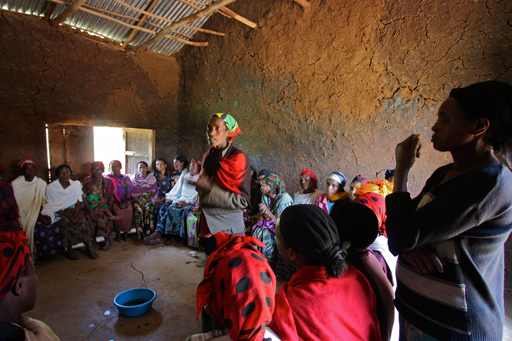
2.3.2 Water Sector Development Programme
The Water Sector Development Programme (WSDP) was issued in 2002 to further elaborate on the Policy and the Strategy. The WSDP is a large document in two volumes that proposes plans and projects throughout all regions of Ethiopia covering the period from 2002 to 2016. It identifies priority intervention areas and projects for this 15-year time period. It includes specific targets for improving water supply and sewerage coverage, and also for irrigation, hydropower, water resource development, and institution and capacity building.
The WSDP focuses particularly on actions to (MoWR, 2002):
- make clean water available for drinking and improve sanitation
- make water available for livestock in nomadic and other special areas
- extend irrigation for agricultural development to the maximum possible
- expand generation capacity to meet hydroelectric power needs
- provide water for industrial development
- provide water for, among other uses, fisheries, tourism and transportation.
The WSDP therefore provides details for implementing the Water Resources Management Policy and the Water Sector Strategy. Figure 2.5 shows the links between the Policy, Strategy and Programme. The Policy was the first to come followed by the Strategy and then the Development Programme. The diagram indicates that this was not a one-way process. Changes in the Development Programme may lead to revisions to the Policy and Strategy as needed.
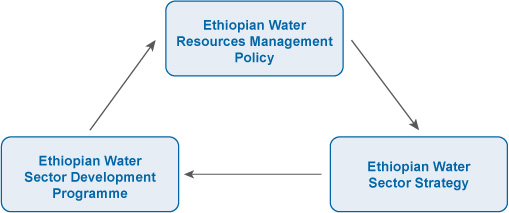
In practice, these three documents – Policy, Strategy and Programme – provided the background and principles for water resource management that led to the development of the One WASH National Programme.
2.4 National Hygiene and Sanitation Strategy
The National Hygiene and Sanitation Strategy (NHSS) was developed by the Ministry of Health and published in 2005. It was designed to complement the existing Health Policy and Water Sector Strategy. Figure 2.6 shows the image on the front cover of the document.
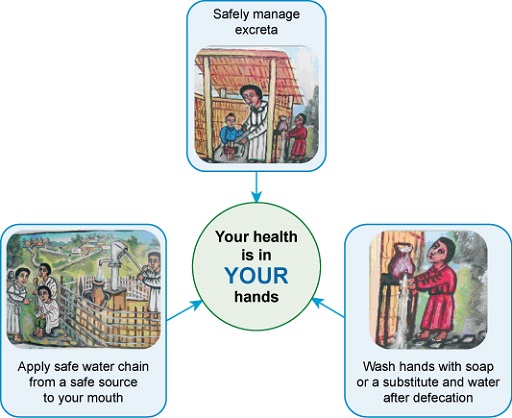
What message is conveyed by the front cover image shown in Figure 2.6?
The three pictures represent the three elements of WASH: safe water supply, sanitation, and hygiene, and shows that all three have a direct impact on personal health.
The Strategy starts with a ‘Sanitation Vision for Ethiopia’, which is ‘100% adoption of improved (household and institutional) sanitation and hygiene by each community which will contribute to better health, a safer, cleaner environment, and the socio-economic development of the country’ (MoH, 2005). The Strategy first describes the current situation (as it was in 2005), and then sets out objectives and plans for achieving the goal of the Vision Statement. It puts forward three strategic pillars for improved sanitation and hygiene:
- Pillar 1: An enabling environment: this refers to such things as policies, regulation, co-operation between sectors, partnership, capacity building etc.
- Pillar 2: Sanitation and hygiene promotion: this means efforts and activities to raise awareness of the importance of sanitation and hygiene to create demand and encourage behaviour change.
- Pillar 3: Improved access to hardware: improved availability of appropriate technology solutions for latrines, handwashing and water supply.
These three pillars were designed to support the plans for improved sanitation and hygiene which would lead to prevention of disease and ultimately contribute to the long-term aim of eradicating poverty in Ethiopia. (You will learn more about the pillars and how they relate to the OWNP in Study Session 5.)
2.4.1 Strategic Action Plan
The full title for this plan is the National Hygiene and Sanitation Strategic Action Plan for Rural, Peri-urban and Informal Settlements in Ethiopia – but it is often referred to simply as the Strategic Action Plan (SAP). This covered the period from 2011 to 2015 and was designed to carry forward the work of the National Hygiene and Sanitation Strategy (NHSS). Its purpose was to be used as a general roadmap for achieving national goals for hygiene and sanitation (MoH, 2011). It is particularly relevant to the planning and budgeting of the OWNP, which you will learn more about in Study Session 14.
2.5 Health Sector Development Programme
The Health Sector Development Programme (HSDP) was developed to implement the policies of the Ministry of Health, including sanitation and hygiene activities. There have been several iterations of the HSDP. HSDP IV, published in 2010, covered the period from 2010 to 2015. HSDP IV is a high-level strategic document that adopts several key principles, including:
- government leadership
- enhanced responsiveness to community health needs
- extensive consultation and consensus with stakeholders
- comprehensive coverage of priority health sector issues (MoH, 2010).
HSDP IV was preceded by HSDP I, II and III, which covered successive periods starting from 1997/8. HSDP II and III saw the development of the Health Extension Programme (HEP). In 2004 the Ethiopian government implemented the HEP as the main vehicle for reaching people in the rural areas of Ethiopia. Health Extension Workers (Figure 2.7) promote health at the kebele level by implementing 16 clearly defined health service packages. Seven of these packages are concerned with promotion of and improvements in hygiene and environmental sanitation.
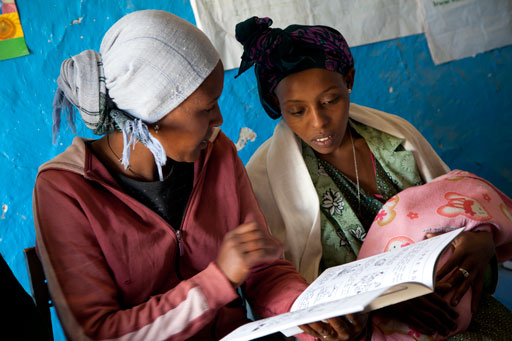
The early successes of the HEP led to its expansion from rural agrarian communities into pastoral and agro-pastoral communities in 2006, and into urban communities in 2010. The Urban Health Extension Programme (UHEP) is now bringing the knowledge and awareness of hygiene and sanitation to town and city dwellers through the activities of urban Health Extension Workers.
2.6 National development plans
Alongside these specific policies, strategies and programmes, the government of Ethiopia has also adopted several major plans for national improvement. The Growth and Transformation Plan (GTP) is a national development plan prepared by the Government of Ethiopia. It aims to improve the national economy and bring an end to poverty by increasing opportunities for commercial agriculture, large-scale industry and infrastructure development. All sector plans are aligned to the GTP. The first phase, GTP I, covered the period from 2010 to 2015. A follow-up plan, GTP II, will cover the next five years to 2020 and is expected to build on progress made so far and set further goals for economic development for Ethiopia. You will learn more about GTP II in Study Session 15.
In 2005, partly in response to the target in Goal 7 of the Millennium Development Goals (see Box 2.1), the Ethiopian government adopted the Universal Access Plan (UAP). The UAP is a national WASH plan that sets out the targets for WASH improvements. It initially covered the period from 2006 to 2010 and was revised to align it with GTP targets and strategies. This second iteration, UAP II, has been in place from 2011 to 2015.
Box 2.1 Millennium Development Goals
In September 2000, the Millennium Summit of world leaders adopted the UN Millennium Declaration, committing their nations to reduce extreme poverty and setting out a series of time-bound targets, with a deadline of 2015, which became known as ‘the Millennium Development Goals’ (Figure 2.8).
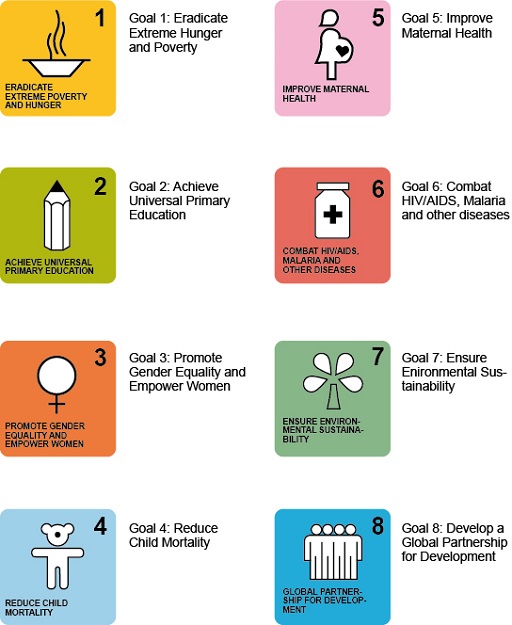
Each goal had specific targets for improvements to be achieved by 2015. The target for access to water and sanitation was included in Goal 7 ‘Ensure Environmental Sustainability’, and aimed to:
Halve, by 2015, the proportion of people without sustainable access to safe drinking water and basic sanitation.
Note that this is stated as a proportion, which means it is not an absolute number of people but depends on the starting conditions. If 100% of a population were without access at the start then the target is achieved if this is reduced to 50% – but this could still amount to many millions of people.
The MDGs have been followed by the Sustainable Development Goals for the period from 2015 to 2030. These are described in Study Session 15.
(Millennium Project, 2000)
Very similar targets for improved water, sanitation and hygiene that had been stated in the Growth and Transformation Plan (GTP) and Universal Access Plan (UAP) were adopted by the One WASH National Programme. The OWNP targets for the Ethiopian population are:
- 98.5% of the population to have access to safe water supply (100% in urban areas; 98% in rural areas)
- reduction of the proportion of non-functioning water supply services to 10%
- 100% access to basic sanitation (improved or unimproved)
- 77% of the population to practise handwashing with soap at critical times
- 77% of the population to practise safe water handling and water treatment at home
- 80% of communities to be ‘open defecation free’ (OWNP, 2013).
Summary of Study Session 2
In Study Session 2 you have learned that:
- Ethiopia has plentiful water resources but they are not distributed evenly. Water and sanitation provision has improved in recent decades, but there is still a great deal more to do.
- The Water Resources Management Policy is the primary policy for water and was followed by the development of the Water Sector Strategy.
- Other related policies include the Health and Environmental policies of Ethiopia. Under the Health Policy, there are other national level strategies and development programmes which are very important for operationalising the policy.
- WASH policies are aligned with the government of Ethiopia’s Growth and Transformation Plan (GTP) to improve the national economy. A second iteration of the GTP is expected to cover the five years from 2015 to 2020.
- The Universal Access Plan (UAP) of 2006 was revised in 2011 to align it with the targets and strategies of the GTP.
- The OWNP targets of 98.5% access to safe water and 100% access to sanitation are based on GTP and UAP targets.
Self-Assessment Questions (SAQs) for Study Session 2
Now that you have completed this study session, you can assess how well you have achieved its Learning Outcomes by answering these questions.
SAQ 2.1 (tests Learning Outcome 2.1)
- a.Define what is meant by a policy, a strategy and a programme. Briefly describe how they relate to each other (look at Figure 2.5).
- b.What is ‘gender mainstreaming’? Suggest two possible benefits of gender mainstreaming in WASH projects.
Answer
- a.A policy is a high-level document (approved by the national government) that states overall purpose and guiding principles. A strategy gives more detailed goals and plans for implementing the policy. A programme is a plan for specific activities, projects or events to implement policies and strategies – for example outlining who, where and what will be done to achieve the strategy goals. Figure 2.5 shows that policies set general principles to guide strategies, strategies shape programmes by setting goals and general plans, and programmes in turn shape policies.
- b.Gender mainstreaming means to keep both men and women in the central focus or ‘mainstream’ of projects, involving them in all aspects and decisions throughout. In practice this means making sure that women are fully involved. There are many benefits you may have suggested. For example, in Ethiopia women and girls are often responsible for collecting water for the family, so involving them in projects allows them to keep ownership of the task and have control over what they will have to do in the future. It also means women will have the chance to shape projects that are suited to their specific needs, such as menstrual hygiene.
SAQ 2.2 (tests Learning Outcome 2.2)
Look at the graph in Figure 2.2. It shows that the percentage of people with access to improved water in 2005 is 37%. Give three reasons why this might not match the percentage of people with improved water access in a particular town or village in May 2005.
Answer
The graph shows the national average for the year. The percentage of people with improved water access might differ from this in a particular town or village in May 2005 because:
- Water is not distributed evenly throughout the year – there are wet and dry seasons.
- Water is not distributed evenly geographically. Some areas of the country have much more water than others.
- There is a marked difference between access in urban and rural populations. Urban populations on average have much greater access to improved water, but they are more densely polluted so often natural resources such as rivers and streams are contaminated.
SAQ 2.3 (tests Learning Outcome 2.3)
Section 2.2 covers the three policy areas related to WASH. For each area, name the main policy leading up to the OWNP and briefly give one way in which it reflects Article 90 of the Ethiopian Constitution.
Answer
The policy areas are water, health and environment. Article 90 of the constitution states that ‘policies shall, to the extent that resources permit, aim to provide all Ethiopians with access to health and education, clean water, housing, food and social security.’
- The main water policy is the Water Resources Management Policy (WRMP). It reflects Article 90 by (you only need to have included one of these):
- promoting efficient, equitable and optimum utilisation of water resources nationally
- stating that water is commonly owned by all the people of Ethiopia
- aiming as far as possible to give all Ethiopian citizens access to a sufficient quantity of acceptable quality water
- recognising the need to adopt strategies that are compatible with other sectors’ goals e.g. health
- promoting involvement of all stakeholders
- setting pricing guides for water so that it is affordable to all and discourages wastage.
- The main health policy is the Health Policy of the Transitional Government. It reflects Article 90 by:
- Integrating with other policy areas (including sanitation and water) to improve health provisions.
- The main environment policy is the Environmental Policy of Ethiopia. It reflects Article 90 by:
- aiming to improve all Ethiopians’ health and quality of life
- ensuring that methods adopted today are compatible with adequate provisions for future generations
- stating that every person has the right to a healthy environment
- aiming to extend the availability of non-renewable resources
- pledging to disseminate affordable technologies.
SAQ 2.4 (tests Learning Outcome 2.4)
For each of the following statements, decide if it applies to the Water Resources Management Policy (WRMP), Water Sector Strategy (WSS) or Water Sector Development Programme (WSDP). Bear in mind how they relate to each other.
- a.It has targets for actions in specific areas like hydropower.
- b.It contains general principles for the use of water nationwide.
- c.It prescribes actions to maximise agricultural irrigation, based on a more general objective to provide sustainable water supply and sanitation services.
- d.It is influenced by the goal to promote sustainable use of water resources across the country, and expands on how this should be done by giving more detailed aims and principles.
- e.It came first, but was shaped by the results of past actions and could be revised due to future actions.
Answer
- a.WSDP
- b.WRMP
- c.WSDP
- d.WSS
- e.WRMP.
SAQ 2.5 (tests Learning Outcome 2.5)
Briefly describe two major national development plans. How have they influenced the goals of the OWNP?
Answer
The Growth and Transformation Plan (GTP) is a plan for national economic development and eradication of poverty. The Universal Access Plan (UAP) is a national plan for WASH improvements. They have influenced the goals of the OWNP because it has adopted similar targets to remain in line with these plans.